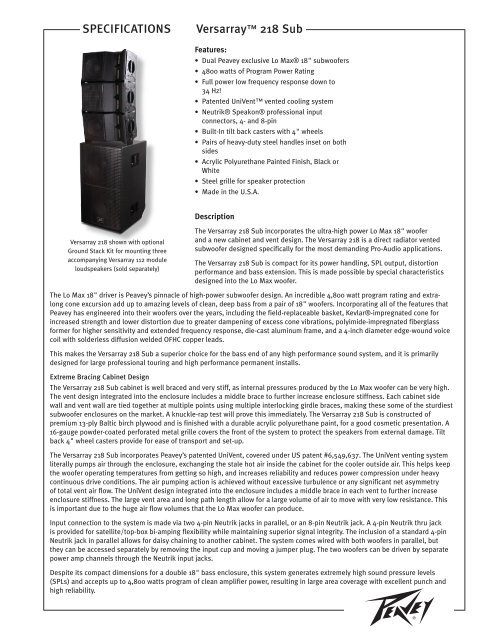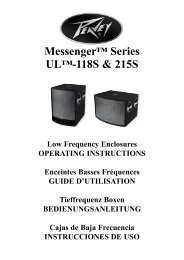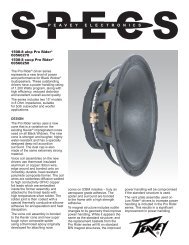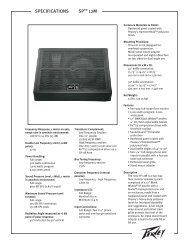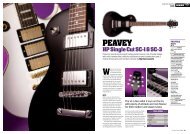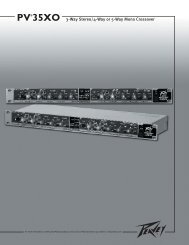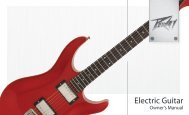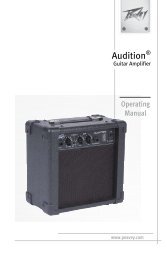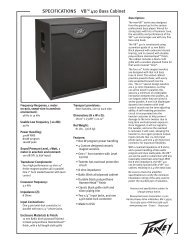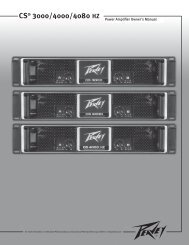SPECIFICATIONS Versarray ™ 218 Sub - Peavey
SPECIFICATIONS Versarray ™ 218 Sub - Peavey
SPECIFICATIONS Versarray ™ 218 Sub - Peavey
Create successful ePaper yourself
Turn your PDF publications into a flip-book with our unique Google optimized e-Paper software.
<strong>SPECIFICATIONS</strong> <strong>Versarray</strong> <strong>218</strong> <strong>Sub</strong><br />
<strong>Versarray</strong> <strong>218</strong> shown with optional<br />
Ground Stack Kit for mounting three<br />
accompanying <strong>Versarray</strong> 112 module<br />
loudspeakers (sold separately)<br />
Features:<br />
• Dual <strong>Peavey</strong> exclusive Lo Max® 18" subwoofers<br />
• 4800 watts of Program Power Rating<br />
• Full power low frequency response down to<br />
34 Hz!<br />
• Patented UniVent vented cooling system<br />
• Neutrik® Speakon® professional input<br />
connectors, 4- and 8-pin<br />
• Built-In tilt back casters with 4" wheels<br />
• Pairs of heavy-duty steel handles inset on both<br />
sides<br />
• Acrylic Polyurethane Painted Finish, Black or<br />
White<br />
• Steel grille for speaker protection<br />
• Made in the U.S.A.<br />
Description<br />
The <strong>Versarray</strong> <strong>218</strong> <strong>Sub</strong> incorporates the ultra-high power Lo Max 18" woofer<br />
and a new cabinet and vent design. The <strong>Versarray</strong> <strong>218</strong> is a direct radiator vented<br />
subwoofer designed specifically for the most demanding Pro-Audio applications.<br />
The <strong>Versarray</strong> <strong>218</strong> <strong>Sub</strong> is compact for its power handling, SPL output, distortion<br />
performance and bass extension. This is made possible by special characteristics<br />
designed into the Lo Max woofer.<br />
The Lo Max 18" driver is <strong>Peavey</strong>’s pinnacle of high-power subwoofer design. An incredible 4,800 watt program rating and extralong<br />
cone excursion add up to amazing levels of clean, deep bass from a pair of 18" woofers. Incorporating all of the features that<br />
<strong>Peavey</strong> has engineered into their woofers over the years, including the field-replaceable basket, Kevlar®-impregnated cone for<br />
increased strength and lower distortion due to greater dampening of excess cone vibrations, polyimide-impregnated fiberglass<br />
former for higher sensitivity and extended frequency response, die-cast aluminum frame, and a 4-inch diameter edge-wound voice<br />
coil with solderless diffusion welded OFHC copper leads.<br />
This makes the <strong>Versarray</strong> <strong>218</strong> <strong>Sub</strong> a superior choice for the bass end of any high performance sound system, and it is primarily<br />
designed for large professional touring and high performance permanent installs.<br />
Extreme Bracing Cabinet Design<br />
The <strong>Versarray</strong> <strong>218</strong> <strong>Sub</strong> cabinet is well braced and very stiff, as internal pressures produced by the Lo Max woofer can be very high.<br />
The vent design integrated into the enclosure includes a middle brace to further increase enclosure stiffness. Each cabinet side<br />
wall and vent wall are tied together at multiple points using multiple interlocking girdle braces, making these some of the sturdiest<br />
subwoofer enclosures on the market. A knuckle-rap test will prove this immediately. The <strong>Versarray</strong> <strong>218</strong> <strong>Sub</strong> is constructed of<br />
premium 13-ply Baltic birch plywood and is finished with a durable acrylic polyurethane paint, for a good cosmetic presentation. A<br />
16-gauge powder-coated perforated metal grille covers the front of the system to protect the speakers from external damage. Tilt<br />
back 4" wheel casters provide for ease of transport and set-up.<br />
The <strong>Versarray</strong> <strong>218</strong> <strong>Sub</strong> incorporates <strong>Peavey</strong>’s patented UniVent, covered under US patent #6,549,637. The UniVent venting system<br />
literally pumps air through the enclosure, exchanging the stale hot air inside the cabinet for the cooler outside air. This helps keep<br />
the woofer operating temperatures from getting so high, and increases reliability and reduces power compression under heavy<br />
continuous drive conditions. The air pumping action is achieved without excessive turbulence or any significant net asymmetry<br />
of total vent air flow. The UniVent design integrated into the enclosure includes a middle brace in each vent to further increase<br />
enclosure stiffness. The large vent area and long path length allow for a large volume of air to move with very low resistance. This<br />
is important due to the huge air flow volumes that the Lo Max woofer can produce.<br />
Input connection to the system is made via two 4-pin Neutrik jacks in parallel, or an 8-pin Neutrik jack. A 4-pin Neutrik thru jack<br />
is provided for satellite/top-box bi-amping flexibility while maintaining superior signal integrity. The inclusion of a standard 4-pin<br />
Neutrik jack in parallel allows for daisy chaining to another cabinet. The system comes wired with both woofers in parallel, but<br />
they can be accessed separately by removing the input cup and moving a jumper plug. The two woofers can be driven by separate<br />
power amp channels through the Neutrik input jacks.<br />
Despite its compact dimensions for a double 18" bass enclosure, this system generates extremely high sound pressure levels<br />
(SPLs) and accepts up to 4,800 watts program of clean amplifier power, resulting in large area coverage with excellent punch and<br />
high reliability.
<strong>SPECIFICATIONS</strong> <strong>Versarray</strong> <strong>218</strong> <strong>Sub</strong><br />
Frequency response, 1 meter on-axis,<br />
swept-sine:<br />
Anechoic environment:<br />
46 Hz – 1.5 kHz (±3 dB)<br />
Half-space environment:<br />
41 Hz<br />
Usable low frequency limit<br />
(-10 dB point):<br />
Anechoic environment: 34 Hz<br />
Half-space environment: 31 Hz<br />
Power handling:<br />
Woofers paralleled<br />
2,400 W continuous<br />
4,800 W program<br />
9,600 W Peak<br />
Woofers driven separately, each<br />
1,200 W continuous<br />
2,400 W program<br />
4,800 W Peak<br />
Sound pressure level, 1 watt, 1 meter:<br />
Woofers paralleled, 2.00 V input<br />
Anechoic environment: 100 dB SPL,<br />
Half-space environment: 106 dB SPL<br />
Woofers driven separately, 2.83V input to<br />
each<br />
Anechoic environment: 103 dB SPL,<br />
Half-space environment: 109 dB SPL<br />
Maximum sound pressure level<br />
(1 meter):<br />
Anechoic environment:<br />
134 dB SPL continuous<br />
140 dB SPL peak<br />
Half-space environment:<br />
140 dB SPL continuous<br />
146 dB SPL peak<br />
Transducer complement:<br />
2 x 18 in. vented<br />
Lo Max® 18 woofer<br />
Box tuning frequency:<br />
36 Hz<br />
Recommended active crossover<br />
frequency region and slope:<br />
120 Hz at 18 dB/octave minimum<br />
Impedance (Z):<br />
Woofers parallel:<br />
Nominal: 4 Ω<br />
Minimum: 3.3 Ω<br />
Woofers separate access:<br />
Nominal: 8 Ω x 2<br />
Minimum: 6.6 Ω x 2<br />
Input connections:<br />
2 x 4-pin Neutrik® Speakon® inputs in<br />
Parallel<br />
1 x 8-pin Neutrik Speakon input<br />
1 x 4-pin Neutrik Speakon thru<br />
(for use with 8-pin Input)<br />
Enclosure materials & finish:<br />
18 mm 13-ply Baltic birch plywood<br />
finished in acrylic polyurethane paint,<br />
black or white<br />
Mounting provisions:<br />
This unit is not designed for over head<br />
suspension.<br />
Dimensions (H x W x D):<br />
43.38 in. x 25.06 in. x 26.30 in.<br />
1102 mm x 636 mm x 668 mm<br />
Net weight:<br />
204 lbs. (92.7 kg)<br />
Companion Loudspeakers<br />
(sold separately):<br />
<strong>Versarray</strong> 112 line array module speaker<br />
system<br />
Optional Accessories:<br />
Ground Stack Kit for mounting the<br />
<strong>Versarray</strong> 112 line array module speaker<br />
system<br />
Frequency Response<br />
This measurement is useful in<br />
determining how accurately a given<br />
unit reproduces an input signal. The<br />
frequency response of the <strong>Versarray</strong> <strong>218</strong><br />
<strong>Sub</strong> is measured at a distance of 1meter<br />
using a 1 watt (into the nominal<br />
impedance) swept-sine input signal. As<br />
shown in figure 1, the selected drivers in<br />
the <strong>Versarray</strong> <strong>218</strong> <strong>Sub</strong> combine to give<br />
a smooth frequency response on the<br />
central axis from 46 Hz to 1.5 kHz.<br />
Power Handling<br />
There are many different approaches to<br />
power handling ratings. <strong>Peavey</strong> rates this<br />
loudspeaker system's power handling<br />
using the AES Standard 2-1984. Using<br />
audio band 40 Hz to 400 Hz pink noise<br />
with peaks of four times the RMS level,<br />
this strenuous test signal assures the<br />
user that every portion of this system<br />
can withstand today's high technology<br />
music. This rating is contingent upon<br />
having a minimum of 3 dB of amplifier<br />
headroom available.<br />
Harmonic Distortion<br />
Second and third harmonic distortions<br />
vs. frequency are plotted in figures 3<br />
and 4 for two power levels. Ten percent<br />
(10%) of rated input power and either<br />
one percent (1%) of rated input power<br />
or one watt, whichever is greater.<br />
Distortion is read from the graph as<br />
the difference between the fundamental<br />
signal (frequency response) and the<br />
desired harmonic. As an example, a<br />
distortion curve that is down 40 dB from<br />
the fundamental is equivalent to 1%<br />
distortion.<br />
Mounting<br />
Caution: This unit is not designed<br />
for overhead suspension!<br />
Architectural and Engineering<br />
Specifications<br />
The loudspeaker system shall have an<br />
operating bandwidth of 46 Hz to 1.5 kHz,<br />
measured on axis at 1m in an anechoic<br />
environment, with +/- 3 dB tolerance.<br />
The nominal output level shall be 100<br />
dB when measured at a distance of one<br />
meter with an input of one watt. The<br />
nominal impedance shall be 4 ohms<br />
when both woofers are wired in parallel,<br />
and two times 8 ohms when wired<br />
for separate powering. The maximum<br />
continuous power handling for a single<br />
cabinet shall be 2,400 watts, maximum<br />
program power of 2,400 watts and a<br />
peak power input of at least 4,800 watts,<br />
with a minimum amplifier headroom of<br />
3 dB. The cabinet shall have two 4"<br />
diameter fixed caster wheels on the<br />
rear bottom corner for tilt back rolling<br />
transport on flat level surfaces. The<br />
outside dimensions shall be 43.38<br />
inches high by 25.06 inches wide by<br />
26.30 inches deep. The weight shall be<br />
204 pounds. The loudspeaker system<br />
shall be a <strong>Peavey</strong> model <strong>Versarray</strong> <strong>218</strong>.<br />
WARNING! The <strong>Versarray</strong> <strong>218</strong> <strong>Sub</strong> is<br />
extremely efficient and handles a<br />
lot of power! This sound system<br />
can permanently damage hearing!<br />
Use extreme care setting the overall<br />
maximum loudness! Due to the clear, clean<br />
sound output of the <strong>Versarray</strong> <strong>218</strong> <strong>Sub</strong> and<br />
the lack of distortion or obvious distress,<br />
the sound level seems much lower than it<br />
actually is. This system is capable of SPL’s<br />
in excess of 140 dB at 1 meter from the<br />
speaker!<br />
3 + 2 YEAR LIMITED WARRANTY<br />
NOTE: For details, refer to the warranty<br />
statement. Copies of this statement may be<br />
obtained by contacting <strong>Peavey</strong> Electronics<br />
Corporation, P.O. Box 2898, Meridian,<br />
Mississippi 39301-2898.
<strong>SPECIFICATIONS</strong> <strong>Versarray</strong> <strong>218</strong> <strong>Sub</strong><br />
dB SPL (re 20 Pa)<br />
dB SPL (re 20 Pa)<br />
dB SPL (re 20 Pa)<br />
110<br />
100<br />
90<br />
80<br />
Amplitude Response Anechoic vs 1/2 Space<br />
<strong>Sub</strong>woofer<br />
70<br />
Anechoic<br />
1/2 Space<br />
60<br />
20 50 100 200 500 1k<br />
Frequency (Hz)<br />
2k 5k 10k 20k<br />
Figure 1<br />
100<br />
50<br />
30<br />
20<br />
Z<br />
( ) 10<br />
5<br />
3<br />
2<br />
120<br />
110<br />
100<br />
90<br />
80<br />
70<br />
60<br />
50<br />
20 50 100 200 500 1k 2k 5k 10k 20k<br />
Frequency (Hz)<br />
2nd Harmonic<br />
3rd Harmonic<br />
Figure 3<br />
130<br />
120<br />
110<br />
100<br />
1<br />
20 50 100 200 500 1k 2k 5k 10k 20k<br />
Frequency (Hz)<br />
Figure 2<br />
90<br />
80<br />
70<br />
Harmonic Distortion : 10% Rated Power<br />
60<br />
20 50 100 200 500 1k 2k 5k 10k 20k<br />
Frequency (Hz)<br />
2nd Harmonic<br />
3rd Harmonic<br />
Figure 4<br />
Impedance<br />
Harmonic Distortion : 1% Rated Power
43.300<br />
<strong>SPECIFICATIONS</strong> <strong>Versarray</strong> <strong>218</strong> <strong>Sub</strong><br />
26.274<br />
25.000<br />
Dimensions<br />
25.000<br />
43.300<br />
26.275
<strong>SPECIFICATIONS</strong> <strong>Versarray</strong> <strong>218</strong> <strong>Sub</strong><br />
Using the <strong>Versarray</strong> <strong>218</strong> <strong>Sub</strong><br />
Caution! The <strong>Versarray</strong> <strong>218</strong> <strong>Sub</strong> can have up to three coupled <strong>Versarray</strong> 112 line array modules stacked above it, using an<br />
optional Ground Stack Kit mounting bracket. When mounting any cabinets above a <strong>Versarray</strong> <strong>218</strong> <strong>Sub</strong>, be sure that the unit is<br />
on flat or level ground, and is not tilted by more than 5 degrees. If the ground or stage surface creates more than a 5 degree tilt,<br />
then do not mount any cabinets above the <strong>Versarray</strong> <strong>218</strong> <strong>Sub</strong>. The optional Ground Stack Kit mounting bracket is intended to<br />
be used with tie-down straps for stability and safety.<br />
Wiring the <strong>Versarray</strong> <strong>218</strong> <strong>Sub</strong><br />
The system comes wired with both woofers in parallel and accessible through the Neutrik® pins 1+ and 1-, but they can be accessed<br />
separately by removing the input cup and moving a jumper plug, then the two woofers can be driven by separate power amp channels<br />
through the Neutrik input jacks, with the top woofer accessible through Neutrik pins 1+ and 1-, and the bottom woofer through pins<br />
2+ and 2-.<br />
Caution! Never drive only one woofer in a <strong>Versarray</strong> <strong>218</strong> <strong>Sub</strong>, this will severely compromise power handling and performance,<br />
resulting in boomy and ill-defined bass!<br />
Speaker Cables<br />
For best results, do not daisy-chain the speaker cable runs, or use small speaker cables to power the <strong>Versarray</strong> <strong>218</strong> <strong>Sub</strong>, run a single<br />
dedicated speaker cable to each <strong>Versarray</strong> <strong>218</strong> <strong>Sub</strong>.<br />
A minimum of 12-gauge speaker cable is recommended, to help maintain damping factor, and due to the high amount of power that<br />
will be sent to the <strong>Versarray</strong> <strong>218</strong> <strong>Sub</strong>. If the speaker cable run is longer than 50 feet, we recommend locating the power amp nearer<br />
the <strong>Versarray</strong> <strong>218</strong> <strong>Sub</strong>, and running a line level signal out to the power amp.<br />
Using Multiple <strong>Versarray</strong> 112’s mounted over a <strong>Versarray</strong> <strong>218</strong> <strong>Sub</strong><br />
The rigging plate hardware allows up to 3 coupled <strong>Versarray</strong> 112 units mounted over a <strong>Versarray</strong> <strong>218</strong> with the use of an optional<br />
Ground Stack Kit mounting bracket set.<br />
Do not mount more than 3 cabinets above a <strong>Versarray</strong> <strong>218</strong> <strong>Sub</strong> using the Ground Stack Kit mounting bracket set.<br />
Crossover Settings<br />
A number of suitable crossover options are available from <strong>Peavey</strong>: the <strong>Peavey</strong> VSX 26 Loudspeaker Controller, the VSX 48<br />
Loudspeaker Controller, and the <strong>Peavey</strong> DigitoolMX. These have available pre-configured set-up files that provide an optimized<br />
crossover, and EQ for a flat response and level set as a starting place for any permanent installation.
NOTES:<br />
<strong>SPECIFICATIONS</strong> <strong>Versarray</strong> <strong>218</strong> <strong>Sub</strong>
<strong>SPECIFICATIONS</strong> <strong>Versarray</strong> <strong>218</strong> <strong>Sub</strong><br />
NOTES:
Features and specifications subject to change without notice.<br />
<strong>Peavey</strong> Electronics Corporation • 5022 Hartley <strong>Peavey</strong> Drive • Meridian, MS • 39305<br />
(601) 483-5365 • FAX (601) 486-1278 • www.peavey.com<br />
80305211<br />
©2006 Printed in the U.S.A.


